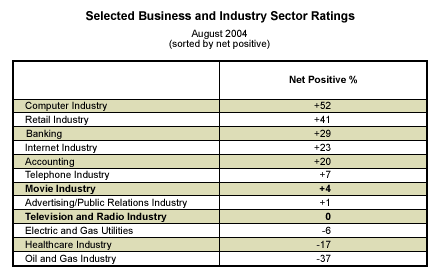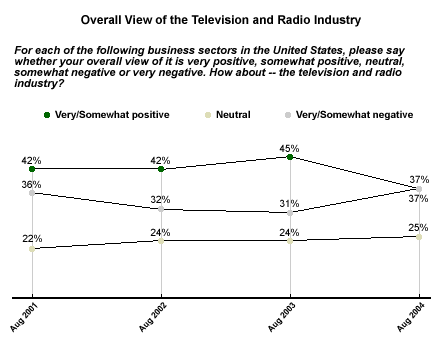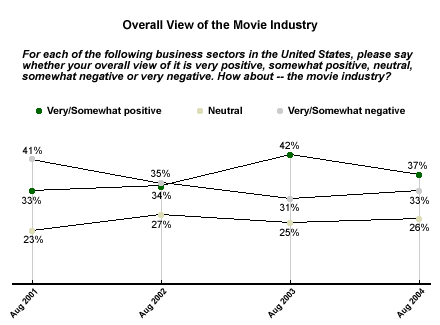Earlier this year, following the Super Bowl halftime show controversy, Gallup asked Americans* whether the entertainment industry needs to "make a serious effort to significantly reduce the amount of sex and violence in its movies, television, and music." Seventy-five percent said the industry should make a serious effort, while 24% thought the industry did not need to make a serious effort. A more recent Gallup Poll confirms that dissatisfaction with the television and movie industries currently runs high relative to Americans' perceptions of other types of businesses.
An Aug. 9-11 survey** asked Americans to rate their overall impressions of 25 different business sectors. Looking at the industries by their "net positive" scores (the total percentage giving a positive rating minus the total percentage giving a negative rating), 16 other industries rank higher than the movie industry, which has a net positive score of +4, and 18 rank higher than the television/radio industry with its net positive score of 0. In comparison, the computer industry ranks first at +52, and the oil and gas industry ranks last at -37.

Television and Radio
The flaps earlier this year about Janet Jackson's wardrobe malfunction during the Super Bowl and the firings of two prominent radio "shock jocks" for "vulgar, offensive, and insulting" behavior turned a critical eye toward the subject of decency in broadcasting. This intense focus may have contributed to the drop in the public's positive view of television and radio during the past year. Only 37% of Americans now say they have a "very" or "somewhat" positive view of the TV and radio industry, compared with 45% in 2003. The percentage expressing a negative assessment rose from 31% to 37%, while the "neutral" percentage remained nearly unchanged. This is the first time since 2001 that positive ratings of the TV/radio industry have not outweighed the negative ratings.
The negative image doesn't seem to have dented Americans' television habits. According to the U.S. Census Bureau, American adults are projected to average 1,669 hours of TV-watching each in 2004 -- 4.57 hours per day, about the same amount as in 2001 (1,661 hours). But the distribution of those hours is shifting: The number of hours spent watching broadcast television declined from 815 in 2001 to a projected 793 this year, while the number of hours watching cable or satellite television has increased from 846 to 873. In addition, the number of hours American adults spend listening to the radio has increased, from 983 hours in 2001 to 1,032 hours in 2004; news-talk is the most popular radio format.

Movie Viewership Declines
According to a Feb. 27 CNN/Money report, 2003 was the first year since 1991 that movie studios brought in less U.S. box office revenue than the year before, as revenue slipped to $9.28 billion from $9.32 billion. There was also a decline in movie attendance last year, from approximately 1.6 billion tickets sold in 2002 to a little over 1.5 billion in 2003, and attendance has declined in three of the past five years.
"Ratings creep," as described in a report released July 13 by the Harvard School of Public Health, may be a factor in decline in movie attendance. The Harvard study found that violence, sex, and profanity increased significantly in movies between 1992 and 2003, and that content garnering an "R" rating in 1992 is routinely found in "PG-13" movies today.
However, the public's overall assessment of the movie industry is only slightly more negative than it was last year, and is actually higher now than it was in 2001. In 2001, 41% of Americans had a "very" or "somewhat" negative view of the movie industry, while 33% had a "very" or "somewhat" positive view. Last year, the positive ratings had increased to 42%, and 37% of Americans rate the movie industry positively in 2004.

Bottom Line
Although the television and movie industries receive poor overall reviews from the American public, there is quality material available. Public television stations and countless cable networks offer educational TV programming, from Sesame Street to the History Channel. And despite mixed reviews, there's no question that movies like Fahrenheit 9/11 and The Passion of the Christ have greatly influenced political and religious dialogue in America. Considering the far-reaching potential that television, radio, and movies have to educate and intellectually challenge people, it's a shame that the bad in these industries tends to outweigh the good in the eyes of Americans.
*These results are based on telephone interviews with a randomly selected national sample of 1,008 adults, aged 18 and older, conducted Feb. 6-8, 2004. For results based on this sample, one can say with 95% confidence that the maximum error attributable to sampling and other random effects is ±3 percentage points. In addition to sampling error, question wording and practical difficulties in conducting surveys can introduce error or bias into the findings of public opinion polls.
**Results based on telephone interviews with a randomly selected national sample of 518 adults, aged 18 and older, conducted Aug. 9-11, 2004. For results based on this sample, one can say with 95% confidence that the maximum error attributable to sampling and other random effects is ±5 percentage points.
